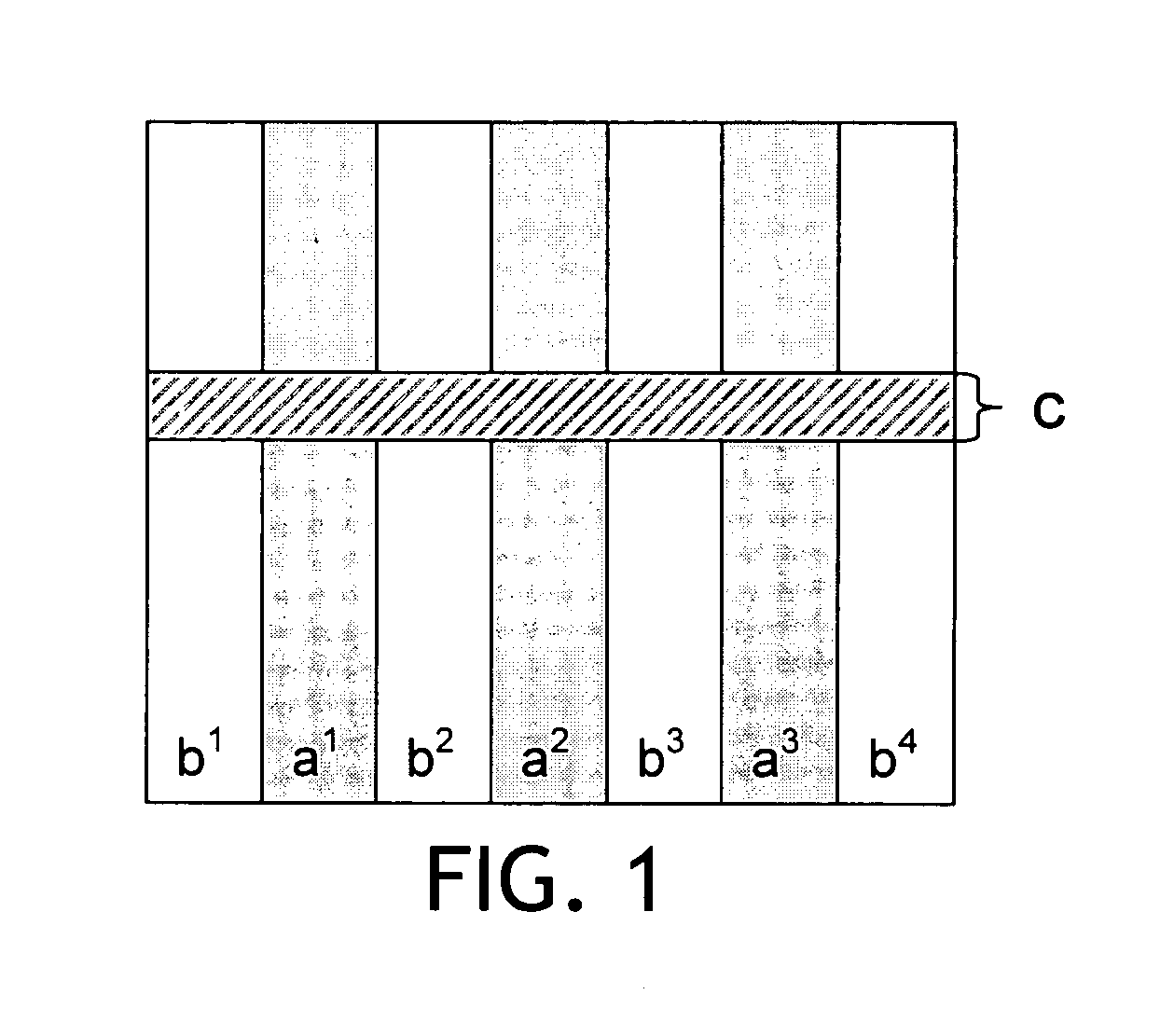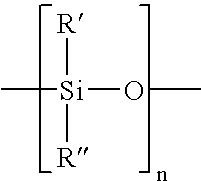Soft tissue hydrophilic tissue products containing polysiloxane and having unique absorbent properties
a technology of hydrophilic tissue and polysiloxane, which is applied in the field of tissue product manufacturing, can solve the problems of reducing the stiffness of tissue sheets, reducing the tensile strength, and hydrophilic bonding, and achieves the effect of improving the hydrophobic stability of polysiloxane treated tissue sheets
- Summary
- Abstract
- Description
- Claims
- Application Information
AI Technical Summary
Benefits of technology
Problems solved by technology
Method used
Image
Examples
examples 1-6
[0158] A single-ply, three-layered uncreped throughdried bath tissue sheet was made generally in accordance with the following procedure using eucalyptus pulp fibers for the outer layers and softwood pulp fibers for the inner layer. Prior to pulping, a quaternary ammonium oleylimidazoline softening agent (Prosoft TQ-1003 from Hercules, Inc.) was added at a dosage of 4.1 kg / Mton of active chemical per metric ton of pulp fiber to the eucalyptus furnish. After allowing 20 minutes of mixing time, the furnish was dewatered using a belt press to approximately 32% consistency. The filtrate from the dewatering process was either sewered or used as pulper make-up water for subsequent pulp fiber batches but not sent forward in the stock preparation or tissue making process. The thickened pulp fiber containing the debonder was subsequently redispersed in water and used as the outer layer furnishes in the tissue making process. The softwood pulp fibers were pulped for 30 minutes at 4 percent co...
examples 7-10
[0163] Examples 7-10 were made in general accordance with the following procedure. The untreated single ply formed tissue sheet used in Examples 1-6 was fed through a uniform pulp fiber depositor (UFD—a type of meltblown die) as described in co-pending U.S. application Ser. No. 10 / 441,143 filed May 19, 2003. The uniform pulp fiber depositor had 17 nozzles per inch and operated at an air pressure of 20 psi. The die applied a fiberized neat polysiloxane composition onto the tissue sheet. The polysiloxanes used in this example included an aminofunctional polyether polysiloxane fluid, Wetsoft CTW, and blends of Wetsoft CTW with a hydrophobic aminofunctional polydimethylpolysiloxane AF-23, and Wetsoft 648, a non-aminofunctional polyetherpolysiloxane all available from Wacker, Inc., Adrian, Mich. For the blend, each component was present in the blend at approximately 33.3% by weight. The fluid was applied by UFD at a rate of 1% and 2% by weight of dried pulp fiber.
[0164] Results in Table...
examples 14-21
[0166] The following Examples demonstrate the superiority of the aminofunctional polyether polysiloxane / aminofunctional polydialkylsiloxane to the known in the art polyether polysiloxane / aminofunctional polydialkylsiloxane blends and to use of surfactants to improve the hydrophobicity. FTS-226 is a 40% silicone solids emulsion containing 50% by weight of a non-aminofunctional polyether polysiloxane and 50% by weight of a hydrophobic aminofunctional polydimethylsiloxane. FTS-226 is manufactured and sold by Crompton, Inc., Greenwich, Conn.
[0167] Examples 14 and 15 show the performance of two commercially available polysiloxane treated facial tissue products. Examples 16 and 17 were prepared in general accordance with the procedure used for preparation of Examples 1-6.
[0168] For Examples 18-21 the polysiloxane was applied via a patterned spray application to a fully bleached eucalyptus pulp fiber tissue sheet having a basis weight of 150 grams oven-dry pulp per square meter and a den...
PUM
| Property | Measurement | Unit |
|---|---|---|
| viscosity | aaaaa | aaaaa |
| viscosity | aaaaa | aaaaa |
| viscosity | aaaaa | aaaaa |
Abstract
Description
Claims
Application Information
 Login to View More
Login to View More - R&D
- Intellectual Property
- Life Sciences
- Materials
- Tech Scout
- Unparalleled Data Quality
- Higher Quality Content
- 60% Fewer Hallucinations
Browse by: Latest US Patents, China's latest patents, Technical Efficacy Thesaurus, Application Domain, Technology Topic, Popular Technical Reports.
© 2025 PatSnap. All rights reserved.Legal|Privacy policy|Modern Slavery Act Transparency Statement|Sitemap|About US| Contact US: help@patsnap.com



